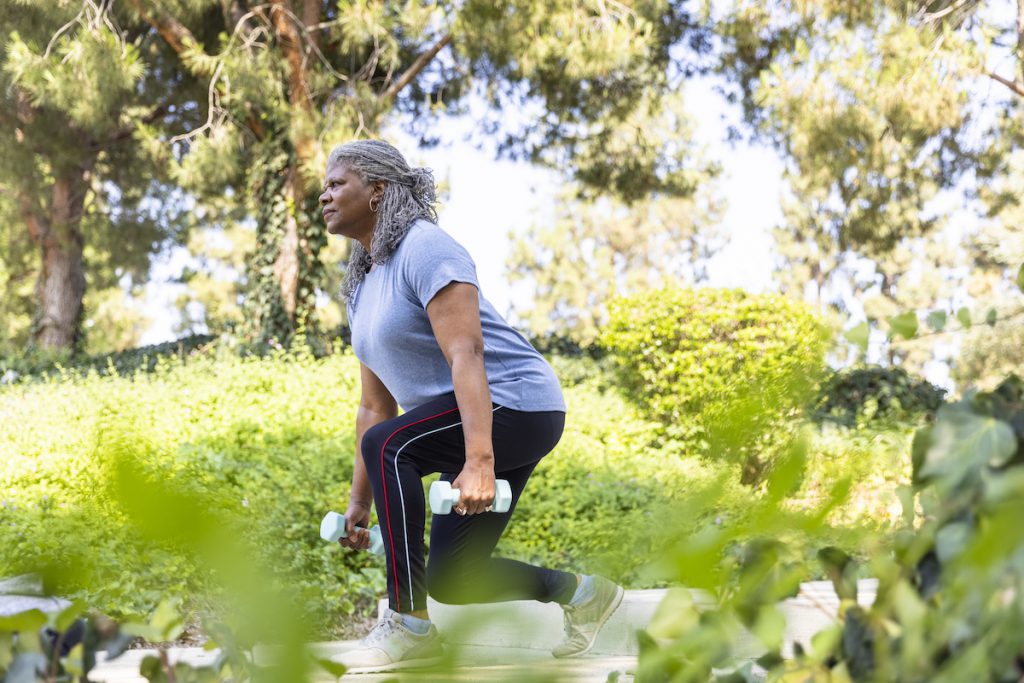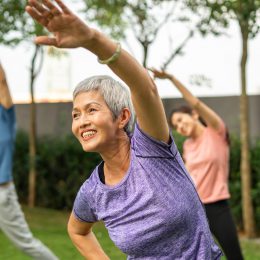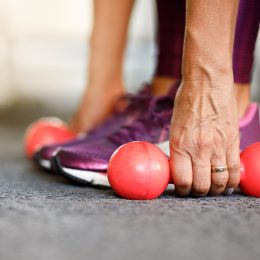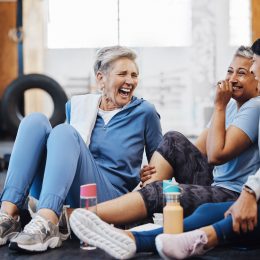5 Must-Know Exercise Modifications for Bad Knees
When your workout causes pain, it’s tempting to skip it altogether. Instead, try these knee-friendly movement swaps.

If achy knees are getting in the way of your favorite workouts or activities, you’re in good company. Frequent knee pain affects about 25 percent of adults, according to research in the Annals of Internal Medicine.
Knee pain is particularly common in seniors, says Theresa Marko, D.P.T., a board-certified orthopedic physical therapist who works with older adults. “We lose muscle flexibility and strength as we age, which can cause some tracking issues of the kneecap [patella],” she says. More specifically, the quadriceps muscles become weaker and consequently have less control over the position of the kneecap in its stabilizing track, known as the femoral or trochlear groove.
The outer hips also tend to weaken with age, which causes the iliotibial band (or IT band, the tendon that runs along the outside of your thigh) to tighten to help support the hip and knee, Marko explains. “Tightness in the IT band can also pull on the kneecap, causing alignment issues.”
And then there’s arthritis. The risk of developing osteoarthritis, the most common type of arthritis, increases with age, as the cartilage that cushions the joints starts to wear away. Arthritis can cause pain when you fully straighten or bend your knee, making certain movements very uncomfortable, Marko says.
If knee pain affects your everyday life, it’s important to see your doctor. They can help figure out the root cause and suggest ways to get relief. For example, you might benefit from working with a physical therapist to improve core and hip strength — which ultimately translates to building a more supportive infrastructure in your body that can relieve pressure on your knees. It’s all connected, after all.
If your pain primarily flares up during or after exercise, certain movements might be to blame. In that case, simple modifications can make all the difference.
Here are five common exercises that put a lot of pressure on the knees — and what to do instead. You can simply swap these exercises into any workout that calls for the problematic movement, doing the same number of recommended reps and sets. For example, if your workout includes three sets of 30 seconds of high knees, do three sets of 30 seconds of marching in place instead.
Add SilverSneakers to your wellness routine! Classes and events are happening daily at participating gyms, online through SilverSneakers LIVE and at community centers near you. Activate your free online account to get started.
Instead of: Side Plank
Try: Modified Side Plank
If you have any sort of knee instability, side planks can be bothersome, says Bethanie Bayha, D.P.T., an orthopedic clinical specialist and clinic director at Real Rehab in Seattle. The extended-leg position puts a high demand on the sides of your knees to stay in place. Dropping to your knees, and bending them about 90 degrees so that your feet are behind you, is a standard adjustment, Bayha says. You can still focus on engaging your core and glutes, but you don’t need to worry about your knees in the process.
Lie on your left side with your knees bent about 90 degrees so that your feet are behind your body. Prop your upper body up on your left forearm with your elbow bent and directly below your shoulder.
From here, raise your hips so your body forms a straight line from head to knees. Make sure you’re pushing straight up, not toward your feet. Your top hip should also be rolled slightly forward. Rest your right hand on your right hip. Hold for as long as your workout calls for, then repeat on the opposite side.
Instead of: Squat
Try: Sit-to-Stand
During a squat, many people don’t hinge properly at the hips, or they put their weight into their heels, which can result in putting too much pressure on the quads and knees. By starting with a sit-to-stand exercise, you’ll be able to focus on the hip hinge movement — you must hinge forward to successfully get up out of the chair. When you get the hang of it (and no longer feel any pain in your knees), you can progress from sit-to-stand to a chair squat to a regular bodyweight squat, Bayha says.
Sit on the edge of a sturdy chair with your feet flat on the floor. Rest your arms on your hips and cross them at your shoulders, or hold them in front of you for counterbalance. Engage your core.
Lean forward from your hips to position your shoulders and trunk over your thighs (this is the hip hinge). Push down through your feet to stand up, straightening through your knees and hips as you rise to a fully erect posture with your hips positioned under your shoulders. Try not to use your arms for help. Pause, then slowly reverse the motion to lower back down. You should be leading with your hips and be able to sit down quietly — no plopping. That’s one rep.
Instead of: Forward Lunge
Try: Reverse Lunge
Forward lunges involve a lot of momentum, which can be difficult to keep under control so that you don’t “fall” forward or put too much pressure on the front of the knee. Reverse lunges, on the other hand, still work the glutes and quads, but they’re often easier to control and are not as irritating on the knees. The key, Bayha says, is to hinge forward slightly at the hips so that your armpits are directly over your front foot. This forward-leaning posture helps put the work into the glutes.
Another important note: Lunges can feel awkward for anyone who struggles with balance, Marko says. If balance is an issue, she recommends doing a split squat instead — taking the step out of it completely — and holding on to a table or counter for support. You can also try one of these reverse lunge modifications.
Stand tall with your feet hip-width apart. Place your hands on the back of a chair or on a countertop for support, if needed. Shift your weight onto one leg and step the other leg behind you, placing your toes on the floor. Hinge forward at the hips so that your torso is leaning slightly forward but your back is still totally flat. Find your balance here. Your rear heel should be off the floor with your weight on the ball of the foot.
Keeping your weight in your front foot, bend both knees to lower down into a squat, aiming to hover your back knee a few inches above the floor. Exhale and push through your front heel to return to standing, bringing your back foot in to meet the front. That’s one rep. Do all reps on one leg, then repeat on the other side.
Instead of: High Knees
Try: Marching in Place
Any exercise that involves jumping, like high knees, is going to put a high amount of pressure on the joints. And that won’t feel great if you have knee problems. Instead of jumping from one foot to the other, slow it down to marching in place. You’ll still engage your core and work up a sweat, but by keeping both feet on the ground in between lifts, you’ll reduce the amount of force placed on your knee joints. Bonus: Marching in place is a great exercise for working the lower abdominal muscles, Bayha says.
Subscribe to our newsletter
It's quick and easy. You could be one of the 13 million people who are eligible.
Already a member? Click to discover our 15,000+ participating locations.
Follow Us
Stand tall facing sideways to a wall, kitchen counter, or the back of a sturdy chair, holding on for support with one hand, if needed.
From here, raise one knee as high as you comfortably can, without leaning backward at the trunk or rounding at the pelvis. Make sure to maintain an upright trunk. Pause, then lower your leg to the starting position. Repeat with your opposite leg. Think about pushing your entire foot through the floor to lift your leg. Pick up the pace if and when you feel comfortable.
Instead of: Step-Down or Stepup
Try: Single-Leg Reach
Step-downs and stepups are both great functional exercises that help you maintain the strength needed to climb stairs and step onto curbs with confidence. But some people find that they bother their knees. That’s because if your knees are weak, they’ll cave inward as you step up or down, Marko says. “This indicates weakness at the hip and/or knee and poor tracking of the kneecap.”
To stop this from happening — and protect your knees in the process — she suggests doing step-downs or stepups in front of a mirror to make sure your knee is tracking directly above your toes. She also recommends using a shorter step. If you still find your knees are caving in or that stepping up or down hurts your knees, try what she calls a reach instead.
Stand tall with your feet hip-width apart and hands on your hips. Shift your weight to one leg, allowing that knee to bend slightly. Your torso will naturally lean forward a little to maintain your balance. (That’s fine!)
From here, reach your non–weight bearing leg out in front of you, as if you were about to walk down a step. Bend your standing knee a little bit more if you can, reaching your extended leg out and down as you do. If your knee starts to cave in, you’ve gone too far, Marko says. Bring your leg back into the starting position. That’s one rep. Complete all reps on one leg, then repeat on the other side.
As your knee gets stronger and more stable, you can progress to doing the movement while standing on a low step, and then eventually to doing the full step-down or stepup motion.
Activate Your FREE SilverSneakers Online Account
Get hundreds of free SilverSneakers On-Demand videos and stay in touch with us by creating your free online account. You don’t have to be a SilverSneakers member to get on-demand workout videos, health and fitness tips from SilverSneakers, and more.
SilverSneakers members can go to thousands of nationwide gyms and fitness locations, plus take SilverSneakers LIVE online classes led by specially trained instructors and designed for all fitness levels and abilities – at no additional cost. If you have a Medicare Advantage plan, it may include SilverSneakers. Check your eligibility here.
Already a member? Get your SilverSneakers member ID, search for locations near you, and all the health and wellness resources you need by logging in to your online member account here.





